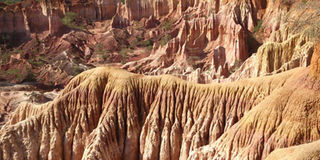Nothing evil in Malindi’s Hell’s Kitchen but a very hot little canyon

Hell's kitchen in Malindi. PHOTO | Morris Kiruga
What you need to know:
- The local residents know it as Nyari, which is Kigiriama for “natural sacred depression”.
- Although Hell’s Kitchen is gazetted, no proper measurements have been made of its depth and expanse.
- Hell’s Kitchen belongs to the local Giriama community.
A 30-minute drive from Malindi town is a small unassuming village with conspicuous baobab trees.
The village is called Marafa, but its proximity to the biodiversity-rich Dakatcha woodlands is not its most outstanding feature. That title goes to the Marafa depression, more famously known as Hell’s Kitchen.
Hell’s Kitchen is an odd sandstone canyon that might be Kenya’s best kept-secret. It looks surreal and most people tend to confuse it for a different gorge, Hell’s Gate, located in Naivasha.
The mini-canyon is officially known as Hell’s Kitchen. The name comes from the high temperatures for which it is famous. No tours are done during the day as the temperatures reach highs of 50 degrees at some point in the canyon.
PLANTS OF MEDICINAL VALUE
The local residents know it as Nyari, which is Kigiriama for “natural sacred depression”.
It was the site for many rituals in days of yore. Medicine men frequented its ever-expanding base to source for natural herbs and other plants of medicinal value. Some sources claim that Nyari means “the place broken by itself.”
Marafa, the town in which Hell’s Kitchen is located, was named by the marginalised Wata community, who preceded the Giriama in the area. Its etymology is unclear, although some local sources suggest that it alludes to the Wata lifestyle of hunting and gathering.
Hell’s Kitchen is a lifeline for the Marafa community. “I went to school through this project,” Tom Jefwa, the current secretary of the Marafa Hell’s Kitchen Tour Operators says. “I used to frequent Hell’s Kitchen as a child and when I didn’t have funds for my education, the community project provided me with a bursary.”
Although Hell’s Kitchen is gazetted, no proper measurements have been made of its depth and expanse.
The place is ever expanding by erosion. The most accessible high viewpoint, direct from the main gate, is protected by a wooden fence. The fence has been moved three times in the past 10 years because the previous one succumbed to erosion.
Local legends tell a very different story from the one of natural erosion. Legend has it that the expanse of Hell’s Kitchen was once occupied by a rich family of the Wakiza clan.
“The family was also selfish and never wanted to share their wealth with their neighbours,” Jefwa says. “They even used to shower with milk.”
To punish their vanity and meanness, God made it rain as heavily as Noah’s flood and the entire homestead sunk, ultimately resulting in the current landscape.
The moral of the story is community and sharing. All the locals believe it. They try to slow down the canyon’s expansion by planting trees on the edges and on neighbouring areas and discouraging any activities that might catalyse the natural destruction. Unabated, the canyon would spread and swallow the current Marafa village and its environs.
According to other versions of the legend, Hell’s Kitchen’s temperatures are a sign of the punishment meted out on the woman who refused to move from a damned town.
The town’s residents had a vision telling them of the forthcoming doom and advised them to evacuate the site. One old woman refused to leave, or could not move from the town. She went down with it when it sank below ground level. What was left from the two legends is the Marafa Depression.
Hell’s Kitchen belongs to the local Giriama community. Since the grounds are sacred to them, no alcohol, cigarettes, or coital activities are allowed inside.
Geological assessments suggest that the area is made up of varying layers of rock. The softer sections are crumbly and sandstone is quickly worn out, leaving sections of hard rocks that emerge as hills inside the gorge.
JAGGED GORGES
It is a sandstone ridge with varying jagged gorges and about five different colours of sandstone. That mix makes the site captivating when the sun is low, at either sunset or sunrise.
The gate charge is Sh250, but that does not include the guide’s fee. The tour operators are fluent in Italian. In fact, most of them are more fluent in Italian than English.
They also have stories like Jefwa’s and any visit to the site is bound to attract groups of pupils from nearby schools.
The students pick up Italian from the guests and the older tour operators, and become fluent at it. One is also bound to spot a few baboons that roam the nearby forest.
Hell’s Kitchen, despite its name, has no evil villain lurking over an oven with a recipe. It is a serene site with a captivating landscape.




